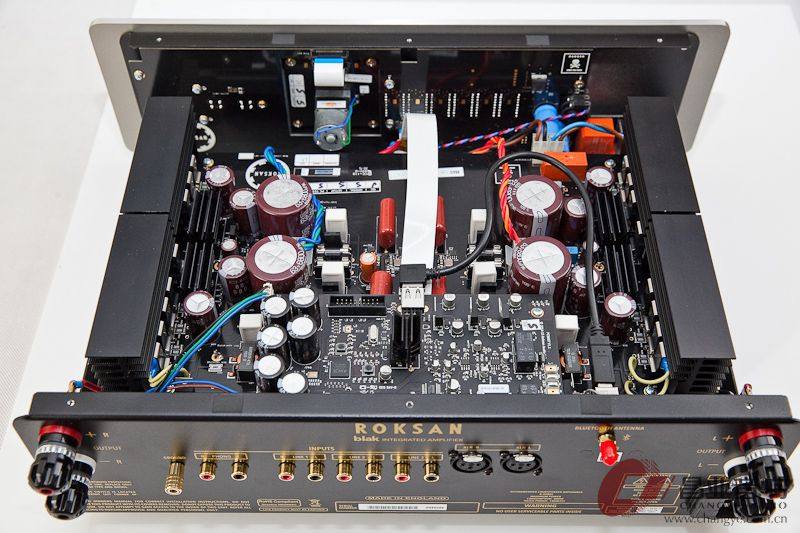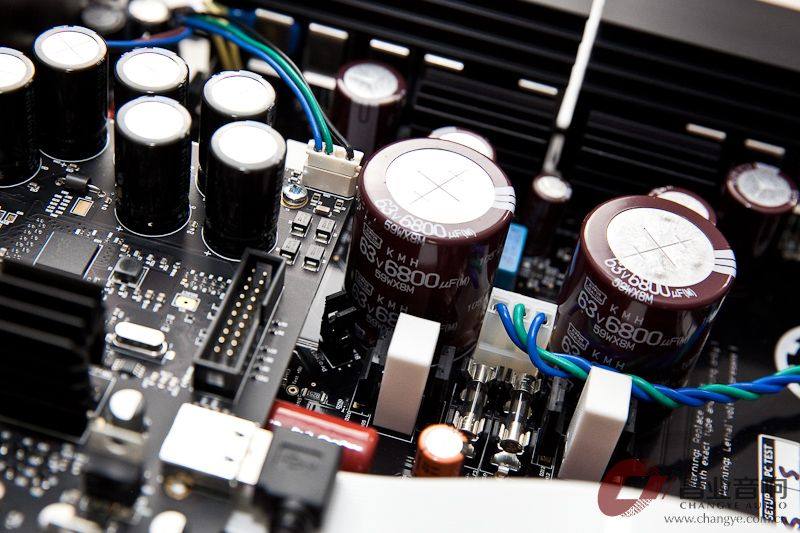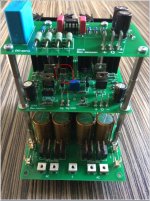Hi,
It is written page up and page down about sonic traits of using different types of coupling capacitors. But in a regular ss power amp, does anyone have any experience in changing feedback resistors for no other reason than sonic improvement?
I got to thinking about this when I swapped the reasonably good Jantzen Superes 10W resistor for Duelund Cast resistor for the tweeter series resistor in my diy speakers. I have done cap swopping a lot, but I have not tried that many resistors.
I found the Jantzens a real upgrade over standard ceramic types, but I was really surpriced at the difference the duelund resistor gave. More so than capacitor I would say.
It is written page up and page down about sonic traits of using different types of coupling capacitors. But in a regular ss power amp, does anyone have any experience in changing feedback resistors for no other reason than sonic improvement?
I got to thinking about this when I swapped the reasonably good Jantzen Superes 10W resistor for Duelund Cast resistor for the tweeter series resistor in my diy speakers. I have done cap swopping a lot, but I have not tried that many resistors.
I found the Jantzens a real upgrade over standard ceramic types, but I was really surpriced at the difference the duelund resistor gave. More so than capacitor I would say.
Feedback resistors should be good metal film types, adequately sized for the thermal dissipation, as they can set the lower limit for amp distortion. Absolutely no point trying anything more exotic. If you want to be really over the top use a string of identical resistors in series, the last one being the bottom half of the divider, then any residual thermal or voltage coefficient will cancel to a first approximation as only the ratio matters and all have the same thermal and voltage environment.
IIRC, JC mentioned in this forum that a possible upgrade of some Parasound amps was changing the feedback resistor to a beter quality (think is was HOLCO).
Other as well mentioned to have very good results with the Charcroft Z-foil resistors, which have very very low thermal coëfficiënt.
As I can not tell the importance or difference out of experience, I do trust others. Besides that, I will be keeping having doubts whether I have taken the best one available.
Picture = Charcroft Z-foil in my current amp as feedback resistor.
Other as well mentioned to have very good results with the Charcroft Z-foil resistors, which have very very low thermal coëfficiënt.
As I can not tell the importance or difference out of experience, I do trust others. Besides that, I will be keeping having doubts whether I have taken the best one available.
Picture = Charcroft Z-foil in my current amp as feedback resistor.
Attachments
I agree with Mark Tillotson.
There are lots of thinks that make more effect in audio quality than just change main feedback resistor type or maker.
Please check the real basic principes of high quality amplifier development.
regards
There are lots of thinks that make more effect in audio quality than just change main feedback resistor type or maker.
Please check the real basic principes of high quality amplifier development.
regards
I find that even cheap carbon film (no name from China) can sound as good as pricey boutique feedback resistors. The carbon film has higher H2 relative to H3, and slightly higher overall THD relative to metal thin film, but they sound better than metal thin film.
Definitely do not use carbon composition or metal oxide thick film.
Definitely do not use carbon composition or metal oxide thick film.
Did you measure the different harmonics?
I would assume something with 100 times the voltage coefficient has more than "slightly" higher THD, and beeing symmetrical around zero it will be mostly third harmonic.
I would assume something with 100 times the voltage coefficient has more than "slightly" higher THD, and beeing symmetrical around zero it will be mostly third harmonic.
What about a current feedback amp? Seems like you pretty much have to use MOX to get a decent power handling. (Or wirewound, but I assume that would be worse?)
Ok,
Here is the reason why I'm asking: I have Roksan Blak amp and Blak cd player.
I used to have considerable more expensive kit than this, but lost a little bit of interest in this hobby. It became more and more about components and chasing after better sound, and less about the acual music.
Well, with this Roksan kit it is the other way around. Everything I play just sounds so fun and full of life.
The tone is not bright, but it's like there is almost a resonanse peak at ssss sounds, driving me nuts. I build my own speakers, and I tried all sorts of stuff, 2nd order, 4th order, low crossover point, high crossover point, but it just will not go away.
But then I came across System7 here on this forum, and his 3rd BW crossovers. And that helped dramatacly. I then made some interconnects of Duelund cables, Duelund power cables and Duelund speaker cables, and then Duelund series resistor on the tweeter. All this helped a bit as well. I would say I'm 95% there.
Now my Blak cdp is on its way to Coris for mods, I have bought Biseki's output transformers and I am sure Coris will find some good tweaks as well. My hope is that this will give me those last 5%.
However, if that ssss sound is still there after those mods, I will turn to the amp.
By the look of it, my first attempt would be changing the coupling caps and ceramic resistors. I would prefer to not do anything drastic in there.


Here is the reason why I'm asking: I have Roksan Blak amp and Blak cd player.
I used to have considerable more expensive kit than this, but lost a little bit of interest in this hobby. It became more and more about components and chasing after better sound, and less about the acual music.
Well, with this Roksan kit it is the other way around. Everything I play just sounds so fun and full of life.
The tone is not bright, but it's like there is almost a resonanse peak at ssss sounds, driving me nuts. I build my own speakers, and I tried all sorts of stuff, 2nd order, 4th order, low crossover point, high crossover point, but it just will not go away.
But then I came across System7 here on this forum, and his 3rd BW crossovers. And that helped dramatacly. I then made some interconnects of Duelund cables, Duelund power cables and Duelund speaker cables, and then Duelund series resistor on the tweeter. All this helped a bit as well. I would say I'm 95% there.
Now my Blak cdp is on its way to Coris for mods, I have bought Biseki's output transformers and I am sure Coris will find some good tweaks as well. My hope is that this will give me those last 5%.
However, if that ssss sound is still there after those mods, I will turn to the amp.
By the look of it, my first attempt would be changing the coupling caps and ceramic resistors. I would prefer to not do anything drastic in there.


Last edited:
I find that even cheap carbon film (no name from China) can sound as good as pricey boutique feedback resistors. The carbon film has higher H2 relative to H3, and slightly higher overall THD relative to metal thin film, but they sound better than metal thin film.
Definitely do not use carbon composition or metal oxide thick film.
In full agreement!
Did you measure the different harmonics?
I would assume something with 100 times the voltage coefficient has more than "slightly" higher THD, and beeing symmetrical around zero it will be mostly third harmonic.
Measurements here:
https://www.diyaudio.com/forums/ana...ender-preamp-40vpp-output-19.html#post5251105
Would you recomend that series/paralell SMD resistor arrangement over something like Kiwame or Takman carbon film resistors?
Last edited:
No, I only did that to test the effect of thermal heating. If you are using a feedback resistor in an application where significant heating is expected, often, paralleling through hole will provide similar benefits. Parallel series has benefit that it gives same value but 4x more dissipation.
Thick film is expectedly crummy. They're comparable to carbon composite, and then the diminutive 0805 size on top of that... The 2P/2S arrangement seems to get you about 3 dB less H3 - I would have expected a bigger difference.
What's perhaps more surprising is that through-hole carbon film seems to be good enough to hit diminishing returns territory in this circuit... H3 only about 1 dB above metal film level. Mind you, in this case we're talking 3.5 mW of power dissipation in what I guess was either a 1/3 W or 1/6 W resistor, while 0805 typically is 1/8 W, plus you wouldn't need much more than a 10 dB reduction... the inherent difference in nonlinearity between thick film (carbon composite) and carbon film would already make for the bulk of the difference.
Perhaps this explains why carbon films were so common in decades past - if derated appropriately, they're good enough. Keep DC away from them, and even excess noise won't be much of an issue.
It stands to reason that a tweeter dropper resistor could be critical... there is no feedback involved at this stage, and power resistors aren't necessarily always the epitome of linearity. Not to mention that the parasitic inductance of wirewounds can be in the same order of magnitude as tweeter voice coil inductance (double-digit µH), so using one of these could throw off your highs response, as good as they are otherwise.
The OP would do well gaining an understanding of the actual physics involved, rather than just brand names.
I see a 3-pin IEC power connector in this blak amplifier - are they using the PE connection for anything else than the installed mains filter?
All that said, an amplifier that you have to shell out 2800 £ for better be good in stock form. I mean, you never really know with these boutique jobs, given how typical reviews of them will be less than insightful in terms of performance, but if it doesn't hum, hiss or buzz, that's definitely a good start.
Sensibly-constructed amplifiers used welll within their power output capabilities all sound pretty much the same anyway. The big, big differences are to be had in speakers. How's dispersion looking for the ones in question?
What's perhaps more surprising is that through-hole carbon film seems to be good enough to hit diminishing returns territory in this circuit... H3 only about 1 dB above metal film level. Mind you, in this case we're talking 3.5 mW of power dissipation in what I guess was either a 1/3 W or 1/6 W resistor, while 0805 typically is 1/8 W, plus you wouldn't need much more than a 10 dB reduction... the inherent difference in nonlinearity between thick film (carbon composite) and carbon film would already make for the bulk of the difference.
Perhaps this explains why carbon films were so common in decades past - if derated appropriately, they're good enough. Keep DC away from them, and even excess noise won't be much of an issue.
It stands to reason that a tweeter dropper resistor could be critical... there is no feedback involved at this stage, and power resistors aren't necessarily always the epitome of linearity. Not to mention that the parasitic inductance of wirewounds can be in the same order of magnitude as tweeter voice coil inductance (double-digit µH), so using one of these could throw off your highs response, as good as they are otherwise.
The OP would do well gaining an understanding of the actual physics involved, rather than just brand names.
I see a 3-pin IEC power connector in this blak amplifier - are they using the PE connection for anything else than the installed mains filter?
All that said, an amplifier that you have to shell out 2800 £ for better be good in stock form. I mean, you never really know with these boutique jobs, given how typical reviews of them will be less than insightful in terms of performance, but if it doesn't hum, hiss or buzz, that's definitely a good start.
Sensibly-constructed amplifiers used welll within their power output capabilities all sound pretty much the same anyway. The big, big differences are to be had in speakers. How's dispersion looking for the ones in question?
Last edited:
No, I only did that to test the effect of thermal heating. If you are using a feedback resistor in an application where significant heating is expected, often, paralleling through hole will provide similar benefits. Parallel series has benefit that it gives same value but 4x more dissipation.
Cordell uses two MF types in series in the Chapter 4 BC-1 amplifier to "minimize temperature and voltage distortion"
It stands to reason that a tweeter dropper resistor could be critical... there is no feedback involved at this stage, and power resistors aren't necessarily always the epitome of linearity. Not to mention that the parasitic inductance of wirewounds can be in the same order of magnitude as tweeter voice coil inductance (double-digit µH), so using one of these could throw off your highs response, as good as they are otherwise.
I’m switching to carbon film on all my crossover tweeter padding resistors from here on out! 🙂
I see a 3-pin IEC power connector in this blak amplifier - are they using the PE connection for anything else than the installed mains filter?
All that said, an amplifier that you have to shell out 2800 £ for better be good in stock form. I mean, you never really know with these boutique jobs, given how typical reviews of them will be less than insightful in terms of performance, but if it doesn't hum, hiss or buzz, that's definitely a good start.
Sensibly-constructed amplifiers used welll within their power output capabilities all sound pretty much the same anyway. The big, big differences are to be had in speakers. How's dispersion looking for the ones in question?
PE is connected to chassis ground. This amp is very quiet, actually dead silent. With no signal I can turn the volume knob right up to max, and there is just a small hiss if I put my ear really close to the speaker.
I have tried several speakers, several sources, and compared it to a couple of other amps. The amp is actually a bit warmer than what I would call neutral, so this ssss sound stands out even more.
This amp has something to it that no other amp I have had, so I am not afraid to spend some time and a few bucks to try and sort this out.
In the DH-220C design, we are using two 6k81(2W) in series with a 511(1W) shuntCordell uses two MF types in series in the Chapter 4 BC-1 amplifier to "minimize temperature and voltage distortion"
- Home
- Amplifiers
- Solid State
- Feedback resistors
